Related Research Articles
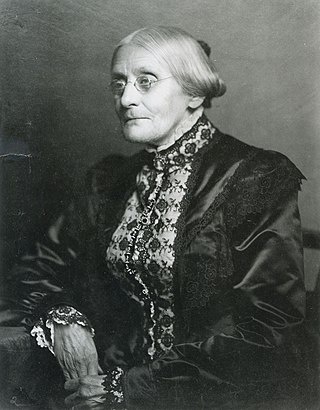
Susan B. Anthony was an American social reformer and women's rights activist who played a pivotal role in the women's suffrage movement. Born into a Quaker family committed to social equality, she collected anti-slavery petitions at the age of 17. In 1856, she became the New York state agent for the American Anti-Slavery Society.
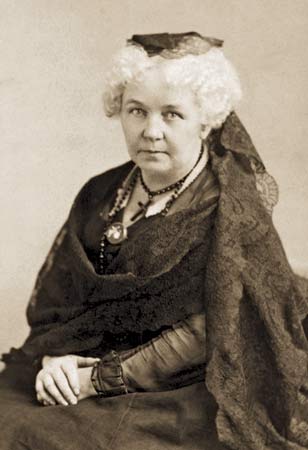
Elizabeth Cady Stanton was an American writer and activist who was a leader of the women's rights movement in the U.S. during the mid- to late-19th century. She was the main force behind the 1848 Seneca Falls Convention, the first convention to be called for the sole purpose of discussing women's rights, and was the primary author of its Declaration of Sentiments. Her demand for women's right to vote generated a controversy at the convention but quickly became a central tenet of the women's movement. She was also active in other social reform activities, especially abolitionism.

The American Anti-Slavery Society was an abolitionist society founded by William Lloyd Garrison and Arthur Tappan. Frederick Douglass, an escaped slave, had become a prominent abolitionist and was a key leader of this society, who often spoke at its meetings. William Wells Brown, also a freedman, also often spoke at meetings. By 1838, the society had 1,350 local chapters with around 250,000 members.

Henry Highland Garnet was an American abolitionist, minister, educator and orator. Having escaped as a child from slavery in Maryland with his family, he grew up in New York City. He was educated at the African Free School and other institutions, and became an advocate of militant abolitionism. He became a minister and based his drive for abolitionism in religion.

Theodore Sedgwick Wright (1797–1847), sometimes Theodore Sedgewick Wright, was an African-American abolitionist and minister who was active in New York City, where he led the First Colored Presbyterian Church as its second pastor. He was the first African American to attend Princeton Theological Seminary, from which he graduated in 1828 or 1829. In 1833 he became a founding member of the American Anti-Slavery Society, an interracial group that included Samuel Cornish, a Black Presbyterian, and many Congregationalists, and served on its executive committee until 1840.
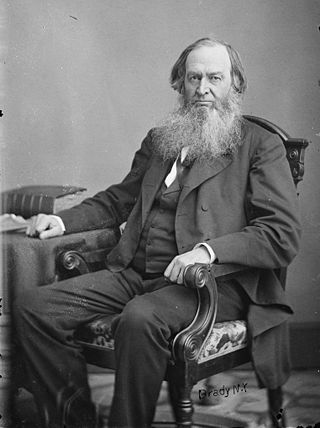
Gerrit Smith, also spelled Gerritt Smith, was a leading American social reformer, abolitionist, businessman, public intellectual, and philanthropist. Married to Ann Carroll Fitzhugh, Smith was a candidate for President of the United States in 1848, 1856, and 1860, but only served a single term in the House of Representatives from 1853 to 1854.
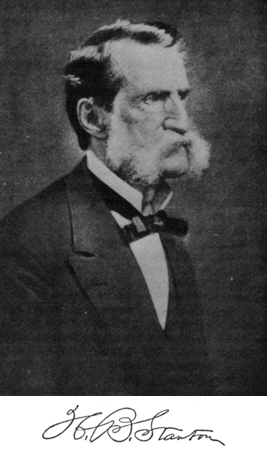
Henry Brewster Stanton was an American abolitionist, social reformer, attorney, journalist and politician. His writing was published in the New York Tribune, the New York Sun, and William Lloyd Garrison's Anti-Slavery Standard and The Liberator. He was elected to the New York State Senate in 1850 and 1851. His wife, Elizabeth Cady Stanton, was a world renowned leading figure of the early women's rights movement.

Alexander Williams Randall was a lawyer, judge and politician from Wisconsin. He served as the sixth Governor of Wisconsin from 1858 until 1861. He was instrumental in raising and organizing the first Wisconsin volunteer troops for the Union Army during the American Civil War.

Women's legal right to vote was established in the United States over the course of more than half a century, first in various states and localities, sometimes on a limited basis, and then nationally in 1920 with the passing of the 19th Amendment.

Mary Burnett Talbert was an American orator, activist, suffragist and reformer. In 2005, Talbert was inducted into the National Women's Hall of Fame.

The Women's Loyal National League, also known as the Woman's National Loyal League and other variations of that name, was formed on May 14, 1863, to campaign for an amendment to the U.S. Constitution that would abolish slavery. It was organized by Elizabeth Cady Stanton, its president, and Susan B. Anthony, its secretary. In the largest petition drive in the nation's history up to that time, the League collected nearly 400,000 signatures on petitions to abolish slavery and presented them to Congress. Its petition drive significantly assisted the passage of the Thirteenth Amendment, which ended slavery in the U.S. The League disbanded in August 1864 after it became clear that the amendment would be approved.
The National Equal Rights League (NERL) is the oldest nationwide human rights organization in the United States. It was founded in Syracuse, New York in 1864 dedicated to the liberation of black people in the United States. Its origins can be traced back to the emancipation of slaves in the British West Indies in 1833. The league emphasized moral reform and self-help, aiming "to encourage sound morality, education, temperance, frugality, industry, and promote everything that pertains to a well-ordered and dignified life." Black leaders formed state and local branches of the league which drew many members, which caused the society to grow quickly, in areas such as Harrisburg, Pennsylvania, where people such as Thomas Morris Chester joined.

William Cooper Nell was an African-American abolitionist, journalist, publisher, author, and civil servant of Boston, Massachusetts, who worked for the integration of schools and public facilities in the state. Writing for abolitionist newspapers The Liberator and The North Star, he helped publicize the anti-slavery cause. He published the North Star from 1847 to 18xx, moving temporarily to Rochester, New York.
The Liberty Party was a minor political party in the United States in the 1840s. The party was an early advocate of the abolitionist cause and it broke away from the American Anti-Slavery Society (AASS) to advocate the view that the Constitution was an anti-slavery document. William Lloyd Garrison, leader of the AASS, held the contrary view, that the Constitution should be condemned as an evil pro-slavery document. The party included abolitionists who were willing to work within electoral politics to try to influence people to support their goals. By contrast, the radical Garrison opposed voting and working within the system. Many Liberty Party members joined the anti-slavery Free Soil Party in 1848 and eventually helped establish the Republican Party in the 1850s.

The American Equal Rights Association (AERA) was formed in 1866 in the United States. According to its constitution, its purpose was "to secure Equal Rights to all American citizens, especially the right of suffrage, irrespective of race, color or sex." Some of the more prominent reform activists of that time were members, including women and men, blacks and whites.
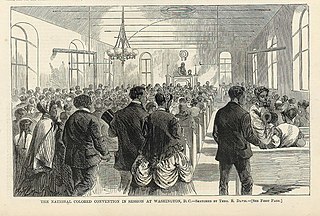
The Colored Conventions Movement, or Black Conventions Movement, was a series of national, regional, and state conventions held irregularly during the decades preceding and following the American Civil War. The delegates who attended these conventions consisted of both free and formerly enslaved African Americans including religious leaders, businessmen, politicians, writers, publishers, editors, and abolitionists. The conventions provided "an organizational structure through which black men could maintain a distinct black leadership and pursue black abolitionist goals." Colored Conventions occurred in thirty-one states across the US and in Ontario, Canada. The movement involved more than five thousand delegates and tens of thousands of attendees.

John C. Bowers was an African American entrepreneur, organist and vestryman at St. Thomas African Episcopal Church, and a founding member of the first Grand United Order of Odd Fellows for African Americans in Pennsylvania. He was active in the anti-slavery movement in Philadelphia, and involved in the founding of several organizations including the Pennsylvania Anti-Slavery Society. "A fervent abolitionist and outspoken opponent of colonization, [he] was much in demand as a public speaker."

Hester C. Jeffrey, néeWhitehurst was an African-American activist, suffragist, and community organizer in Rochester, N.Y., and New York City. She is known for her involvement with the Political Equality Club, the Women's Christian Temperance Union, and the National Association of Colored Women's Clubs.
Barbara Ann Steward was a teacher, lecturer, and outspoken advocate against slavery and for industrial education for people of color. She was the daughter of the famous abolitionist Austin Steward.
The National Convention of Colored Citizens was held August 15–19, 1843 at the Park Presbyterian Church in Buffalo, New York. Similar to previous colored conventions, the convention of 1843 was an assembly for African American citizens to discuss the organized efforts of the anti-slavery movement. The convention included individuals and delegates from various states and cities. Henry Highland Garnet and Samuel H. Davis delivered key speeches. Delegates deliberated courses of action and voted upon resolutions to further anti-slavery efforts and to help African Americans.
References
- 1 2 3 4 5 6 7 8 9 10 11 12 13 14 15 16 17 18 19 20 Herron, Paul E. (April 2022). ""This Crisis of Our History": The Colored Conventions Movement and the Temporal Construction of Southern Politics". Studies in American Political Development. 36 (1): 21–40. doi:10.1017/S0898588X21000122. ISSN 0898-588X. S2CID 246985506.
- ↑ "State Conventions". Colored Conventions Project, University of Delaware.
- ↑ "1840 New York State Convention of Colored Citizens held in Albany". Colored Conventions Project, University of Delaware. Retrieved February 25, 2020.
- ↑ Bell, Howard H. (October 1957). "National Negro Conventions of the Middle 1840s: Moral Suasion vs. Political Action". The Journal of Negro History. 42 (4): 247–260. doi:10.2307/2715512. ISSN 0022-2992. JSTOR 2715512. S2CID 149806791.
- 1 2 3 4 "Free-Suffrage Convention--Second Day's Proceedings". The New York Times . September 25, 1857. ISSN 0362-4331 . Retrieved January 31, 2023.
- ↑ "Smith, Stephen". Encyclopedia.com. Retrieved January 31, 2023.
- ↑ "Gerrit Smith and his Colored Friends". The New York Times . October 7, 1858. ISSN 0362-4331 . Retrieved January 31, 2023.
- ↑ Ward, William Hayes (1909). Proceedings of the National Negro Conference 1909. New York, May 31 and June 1. New York Public Library. New York, N.Y.: National Negro Conference – via Internet Archive.